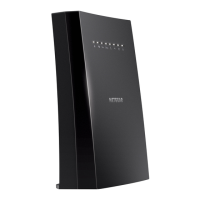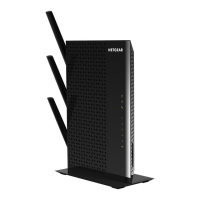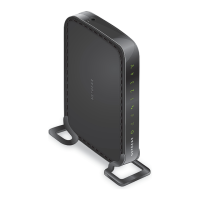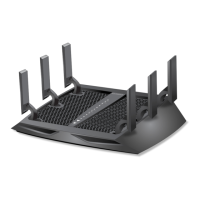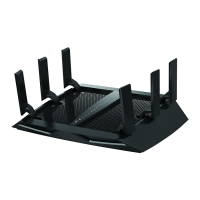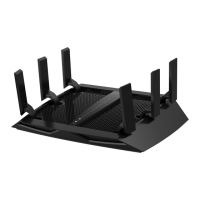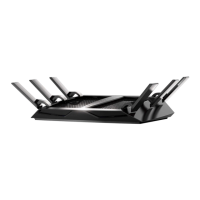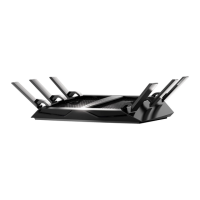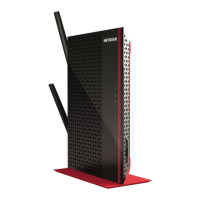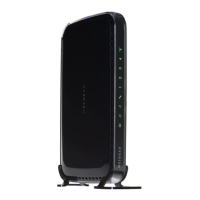Do you have a question about the NETGEAR Nighthawk X6 and is the answer not in the manual?
Step-by-step instructions for installing and setting up the WiFi range extender.
Guide to configuring the extender to function as a WiFi access point.
Instructions for connecting computers and mobile devices to the extender.
Steps to access and log into the extender's web management interface.
Utilizing the Smart Setup wizard for a simplified extender configuration process.
Control the feature that unifies extender and router WiFi network names (SSID).
Reset the extender to its original factory configuration and settings.
Check for and install the latest firmware to improve performance and security.
Methods to locate the extender's IP address for direct access or troubleshooting.
Troubleshooting steps to resolve issues preventing connection to the extender.
Solutions for problems encountered when connecting to a WiFi network.
Steps to troubleshoot and resolve issues accessing the extender's web interface.
Step-by-step instructions for installing and setting up the WiFi range extender.
Guide to configuring the extender to function as a WiFi access point.
Instructions for connecting computers and mobile devices to the extender.
Steps to access and log into the extender's web management interface.
Utilizing the Smart Setup wizard for a simplified extender configuration process.
Control the feature that unifies extender and router WiFi network names (SSID).
Reset the extender to its original factory configuration and settings.
Check for and install the latest firmware to improve performance and security.
Methods to locate the extender's IP address for direct access or troubleshooting.
Troubleshooting steps to resolve issues preventing connection to the extender.
Solutions for problems encountered when connecting to a WiFi network.
Steps to troubleshoot and resolve issues accessing the extender's web interface.
| Ethernet LAN | Yes |
|---|---|
| Cabling technology | 10/100/1000Base-T(X) |
| Networking standards | IEEE 802.11a, IEEE 802.11ac, IEEE 802.11b, IEEE 802.11g, IEEE 802.11n, IEEE 802.3, IEEE 802.3ab, IEEE 802.3u |
| Ethernet LAN data rates | 10, 100, 1000 Mbit/s |
| Ethernet LAN interface type | Gigabit Ethernet |
| Modulation | 256-QAM |
| Wi-Fi band | No |
| Wi-Fi standards | 802.11a, Wi-Fi 5 (802.11ac), 802.11b, 802.11g, Wi-Fi 4 (802.11n) |
| Top Wi-Fi standard | Wi-Fi 5 (802.11ac) |
| WLAN data transfer rate (max) | 1300 Mbit/s |
| Rack mounting | - |
| Frequency range | 2.4 - 5 GHz |
| USB ports quantity | 2 |
| WLAN data transfer rates supported | 600, 1300 Mbit/s |
| Ethernet LAN (RJ-45) ports | 5 |
| Security algorithms | WPA-PSK, WPA2-PSK |
| Product color | Black |
| Flash memory | 128 MB |
| Processor frequency | 1000 MHz |
| Windows operating systems supported | Windows 2000, Windows 2000 Professional, Windows 7 Enterprise, Windows 7 Enterprise x64, Windows 7 Home Basic, Windows 7 Home Basic x64, Windows 7 Home Premium, Windows 7 Home Premium x64, Windows 7 Professional, Windows 7 Professional x64, Windows 7 Starter, Windows 7 Starter x64, Windows 7 Ultimate, Windows 7 Ultimate x64, Windows 8, Windows 8 Enterprise, Windows 8 Enterprise x64, Windows 8 Pro, Windows 8 Pro x64, Windows 8 x64, Windows Vista Business, Windows Vista Business x64, Windows Vista Enterprise, Windows Vista Enterprise x64, Windows Vista Home Basic, Windows Vista Home Basic x64, Windows Vista Home Premium, Windows Vista Home Premium x64, Windows Vista Ultimate, Windows Vista Ultimate x64, Windows XP Home, Windows XP Home x64, Windows XP Professional, Windows XP Professional x64 |
| Cables included | LAN (RJ-45) |
| Depth | 226.8 mm |
|---|---|
| Width | 295.5 mm |
| Height | 54.5 mm |
| Weight | 1100 g |
